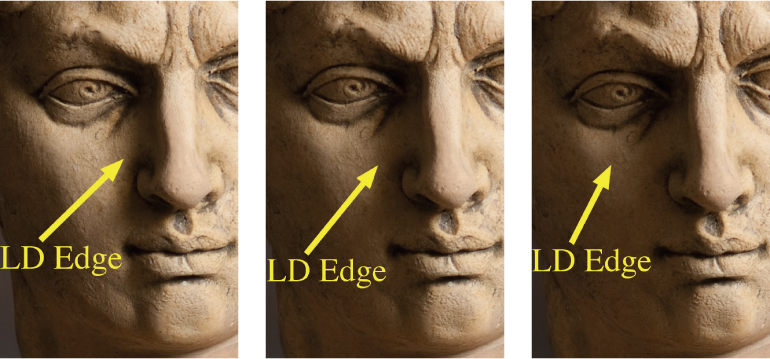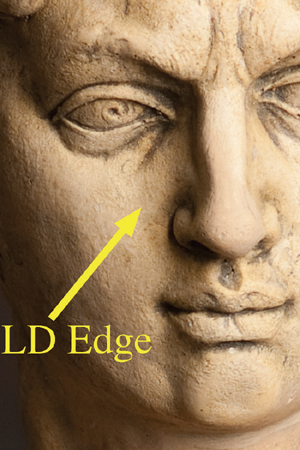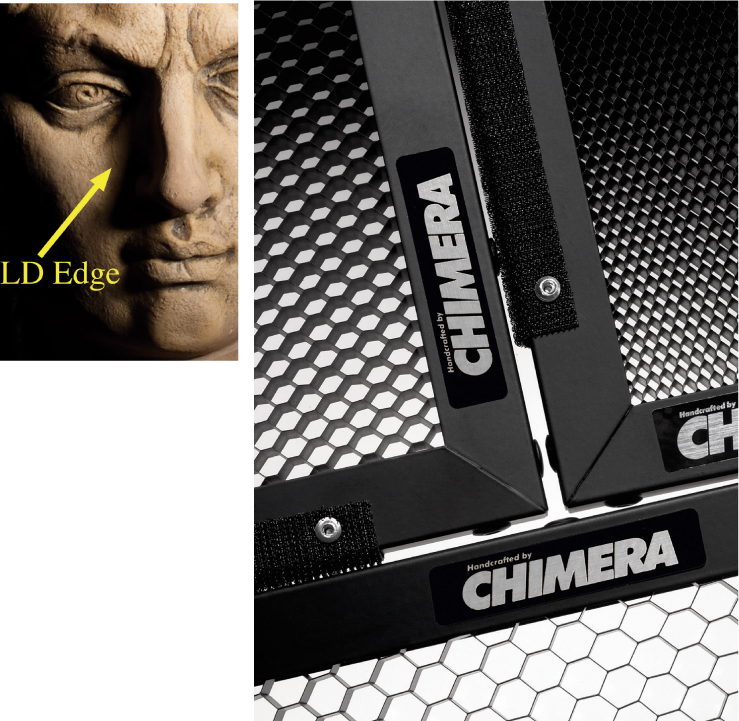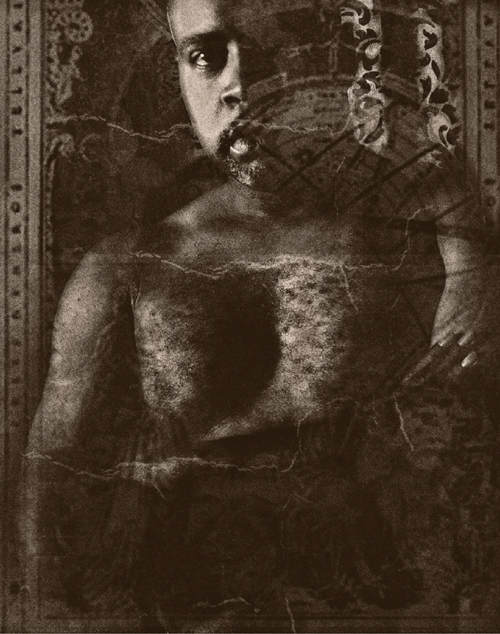4 Light Modification

The key light for this portrait was a parabolic reflector with a diffuser dome over the flashtube, creating a complex highlight that embeds a diffuse highlight in a highly directional light source © Tim Meyer
Light is the medium that makes photography possible, and it is the way that the light is modified that allows a portrait to take on uniqueness and become visually exciting. Light modification techniques allow the portraitist to accent or diminish intensity, change the lighting ratio, and adjust color to make the portrait more than just a picture of a person. Because of this, light modification is one of the most important technical aspects of portrait photography.
Modification Optics
A brief explanation of the optics involved is the best way to begin this discussion of light modifiers. Optics is the study of how light interacts with materials. While we are interested in the qualities of the light that reaches our subject, it is the modifiers and their interaction that establish those light qualities. Of the seven basic optical interactions in portrait lighting, we use four: reflection, scattering, refraction, and absorption/transmission.
Reflection is the most frequently used optical concept in portrait lighting. All lighting equipment, except a bare bulb, uses a reflector to direct the light from the flashtube toward the subject. Regardless of whether the reflector is on the light, a fill card, mirror, or umbrella, the same rule of reflection applies: that is, the angle of the light equals the angle of the reflection. This means that if light strikes the reflecting surface at a 30° angle, then the reflection will also be at a 30° angle. (The angle is measured from the perpendicular at the point that the light strikes the reflecting surface.)
Without going into great detail, the structure of the reflecting surface determines the quality of the reflected light. The more polished and shiny the surface, the more direct the reflection. This type of shiny surface is called a specular surface. When a surface is textured, it reflects diffuse light and is referred to as a diffuse surface. The more textured the surface, the more diffuse the reflection. Both of these surface reflections remain true regardless of the shape of the surface. We see the reflections better from specular surfaces than from diffuse surfaces. If a surface is curved outward (convex), diffuse surfaces will spread the light. If the surface is curved away from the subject (concave), specular surfaces will concentrate the light.
Color needs to be discussed in terms of reflection. When light interacts with a neutral surface, the color of the reflected light will be unchanged. However, if the surface has a color, the reflected light will take on the color bias of the surface.
The second optical interaction that is frequently used in light modification is scattering. This is done in two ways: by reflecting light from a rounded surface and by reflecting light as it passes through a material. In the first method, as the light reflects from a rounded object, the direction of the reflection changes as the reflecting surface changes. The myriad changes in the directions of reflections over an area create the scattering.
In the second method, light passes through a material and is scattered by it. This makes a larger light source and allows the light to strike the subject from many angles across the larger light pattern. Whether the light passes through a cloudy sky, rip-stop nylon, or plastic, it is distributed over a larger area. In certain situations, as with fog, the scattering becomes intensified as the light reflects from the subject toward the camera.
The third optic interaction that is involved in light modification is refraction, or the bending of light. This is how lenses work, and some lighting equipment uses lenses to control the light.
Finally, light is modified by the amount of absorption or transmission that a material provides. This is important for both filtration and shadow creation. It is easier to think of blocking any light that creates shadows; however, absorption not only stops light from creating shadows, it also helps reduce reflection. When a surface is darker, there is more absorption and less light reflected. Absorption also removes colors from reflected light that give it a color bias.
A significant issue is the way light falls off as it is blocked. Distances between the light source, what creates the shadow, and what catches the shadow contribute to the sharpness of the shadow or falloff of the light. The sharpness of the shadow at the edge is the penumbra created by the blocking element, the size of the light source, and the distance to the shadow-catching surface.
Basic Reflectors and Domes
The light sources used in portrait photography emit light in all directions, but we need the light to be controlled and fall on our subject or a targeted area. In most situations, we want the light formed into a beam. Large or small, soft or hard, we want the light to travel along a predictable path to the targeted area. We can adjust a beam of light via the shape and positioning of the reflector.
When the reflector has a shallow shape, the light has a weak beam and spreads in what is commonly known as a flood pattern. The flood pattern tends to be stronger in the center with the light falloff away from the beam’s axis. A pebbled surface on the reflector spreads the light more evenly but does not eliminate falloff.
As the reflector’s shape becomes deeper, the beam of light becomes tighter. Unless the light is totally directed into the reflector, there will always be some flooding. Directing the light into a deep spherical or parabolic-shaped reflector creates a very tight and focused light beam.
Some systems allow focusing by moving the reflector position in relation to the flashtube. This makes the flash unit function as a “zoom” unit, meaning that the light can be varied from a flood characteristic to more of a spot characteristic.
There are also specialized reflectors, such as “beauty dishes,” large, shallow parabolic reflectors that produce a soft directional light with mostly collimated characteristics. Other reflectors are designed to create very specular light that approximates sunlight. Depending on the electronic flash system, specialized reflectors can support the use of other light modifiers such as grids.
A small reflector creates specular LD Edges with well-defined boundaries and dark shadows
Many electronic flash units have transparent or translucent domes over the flashtube. These domes provide protection against failure of the flashtube or modeling light as well as modifying the light source. A clear dome has little effect on the quality of light, though sandblasting, texturing, or pebbling its surface breaks up the light and softens it somewhat. Translucent domes create a more diffuse light source. There are also globes that fit over the flashtube to make the light take on the characteristics of a household light-bulb.

A deep reflector creates a more directional light source. Other flash units move the light source in relation to the reflector, allowing focusing of the light.
(Courtesy of Profoto)
Soft Light Modifiers
All diffuse or soft light is not the same. Rather, it is part of a spectrum of light quality that goes from hard and specular to soft and diffused. As part of this discussion, we will also include the amount of directionality that the light processes.
Soft or diffuse light is usually the preferred key lighting for portraits. This is because diffuse light reduces the texture of skin. Therefore, we will first look at how to modify light to achieve diffuse light.
For many portraitists, umbrellas are the most common modifiers used to spread and concentrate light. There are several types of umbrellas, all of which look, open, and hold their shape in the same manner as a common rain umbrella. Umbrellas designed for photography have their central shaft extend through the reflector or main housing of the flash unit. Normally the shaft can be adjusted to change the distance to the umbrella’s surface.
We can easily separate umbrellas into transmitters and reflectors. Transmission umbrellas are constructed of white translucent materials that allow the light coming from the flash unit to travel through the umbrella and be diffused. Adjusting the distance of the flash unit from the umbrella changes the size of the illuminated circle on the umbrella’s surface. Depending on the density of the umbrella material, the light source can penetrate it and create a slightly specular light.
Reflection umbrellas present many options in their construction and function. They direct light into the umbrella which is then bounced back toward the subject. Most have a black covering on the back that prevents the light from illuminating the area away from the posing area.
The depth and shape of the umbrella are important considerations. As an umbrella becomes deeper, it becomes more restrictive in the light pattern that it produces. The pattern can also be controlled by positioning the flashtube in relation to the actual focus (for parabolic umbrellas) or the apparent focus (for spherical umbrellas). As the flashtube’s position becomes farther away, the light reflecting from the umbrella’s surface approaches a collimated form; that is, parallel light rays.
The final consideration for umbrellas is their reflective surface material. The inner surfaces can be either white or metallic. Metallic surfaces produce higher amounts of reflection, offer greater efficiency in concentrating light, and produce a more specular light. The metallic umbrellas come in gold and silver; the gold color gives more warmth to the light.
The light characteristics of umbrellas produce a defined but soft LD Edge. The edge becomes sharper the farther away the umbrella is from the subject. The umbrella’s distance from the subject defines the highlight dynamic as well. As the umbrella moves farther away, the relative intensity between specular and diffused highlights increases.
When a very large umbrella is required, “giant reflectors” fit the bill. Manufactured with diameters of eight feet or larger, they are based on a parabolic design; the flashtube is aimed at the metallic surface from the focus of the parabola. The light comes off in a large, even, parallel pattern. This system is positioned behind the camera, so the LD Edge falls to the sides of the subject with weak highlights on the front.
Softboxes are self-contained diffusion panels with a controlled light source contained within a housing. The construction of most softboxes uses an external ribbed frame, a cloth covering, and a mounting system for the flashtube. From the outside, the softbox appears as a black, tentlike structure with a white panel across the front. The material on the interior rear surface is white or metallic with a laminate or backing of black opaque material facing out. As in the case of umbrellas, the black backing restricts the light exiting the structure other than through the diffuser panel.
When the reflector is broadened and flattened to a more parabolic shape, the light is spread, becoming slightly diffused while maintaining strong directionality. This is the design of a beauty dish that produces an LD Edge that is slightly softened.
(Courtesy of Profoto)
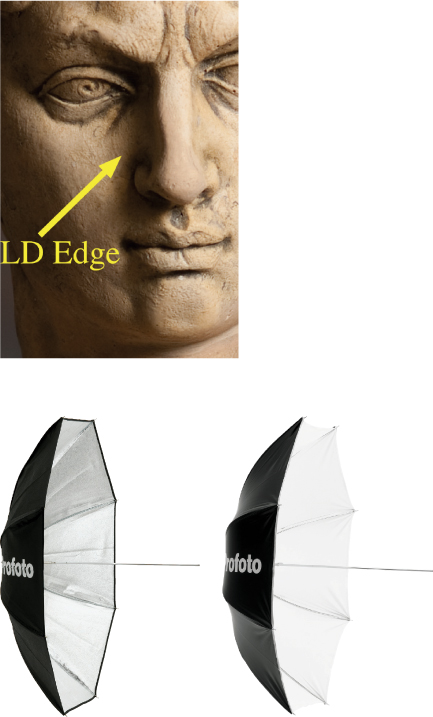
The flash unit is pointed into the reflective surface, spreading the light across the umbrella and producing a diffuse light with a definite direction. The LD Edge is seen as softened while still developing good shadows.
(Courtesy of Profoto)
© Tim Meyer
When an umbrella is rotated, two things happen: As the light rotates, the angle of the light changes, moving the LD Edge. Also, if the light is rotated toward the back of the subject, the light becomes closer, creating an accent on edges on the umbrella’s side of the subject.
The structure bounces all the light from the flashtube (which is held inside at the rear) toward the white diffusion panel that stretches across the front. As with diffusion panels, if the light within the softbox is directed at the subject, there is an embedded specular portion to the light. To diminish this specularity, many softboxes stretch an additional diffusion panel between the flashtube and the front panel.
The common light dynamic for softboxes is smooth and broad highlights with gradual LD Edges. The larger and closer the softbox is to the subject, the more gradual the transition in the LD Edge. In addition, the specular highlights appear less distinct. Most softboxes have rectangular front diffusion panels, but other shapes and modifications can be used. Many photographers wish to avoid rectangular catchlights reflecting in the eyes of the subject. For this reason, softboxes are manufactured as polygons or octogons, and with circular masks on the front diffusion panel to create round catchlights.
Softboxes are also constructed as long and narrow strip lights. Highlights created by a strip light are longer and parallel to the length of the light. The LD Edge will be longer and smoother when the LD Edge’s transition is in the same direction as the strip, and vice versa. This produces complex highlights and LD Edges as they change in relation to the direction of the strip. When an umbrella is used at a substantial angle to the subject, the light reflecting onto the subject acts similarly to a strip light.
Silvered giant reflectors
(Courtesy of Profoto)

A globe creates a softer and more diffused light than the flashtube
(Courtesy of Profoto)
Various shapes and sizes of softboxes
(Courtesy of Profoto)
A softbox creates diffuse light with a soft LD Edge when the softbox is close to the subject
Softboxes are manufactured in various sizes from very small (approximately 1 foot) to extremely large (5 feet). A modification of the softbox concept features multiple flash-head units up to 40 feet in length.
Not all light diffusers in portrait setups are umbrellas or softboxes. Various mirrors, panels, cards, and frames can be used to reflect soft light. Reflectors are commonly used for fill light because they tend to have less intensity and weaker specular characteristics. If the reflector is flat, it cannot increase the specularity of the light landing on it. For example, a mirror reflects diffuse light if that is the light illuminating it, but it cannot change diffuse illumination to specular if the mirror is flat. However, a concave reflector, with the center of the panel curved away from the reflection, tends to concentrate the light.
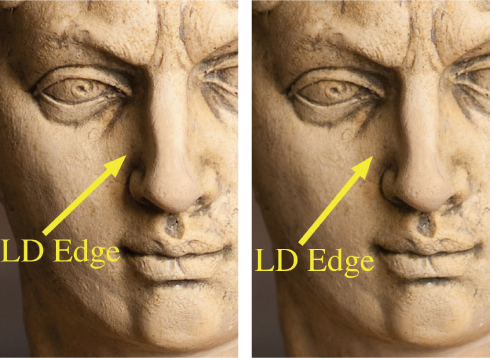
The two details show the effect of using a small and large softbox 58 inches from the subject. The larger softbox creates more diffuse light, as can be seen in comparing the LD Edges.
Often reflectors are mounted to panels that can also be used to hold diffusion materials. Others are attached to flexible, collapsible frames. Any material that reflects light can be used. One of the easiest and least expensive light modifiers is a piece of white cardboard or foamcore. Any colors or materials can be used, and it is quite common to find manufactured reflectors with a metallic surface on one side and white on the other side.
If a panel has a translucent material, the light projected onto the back of the panel scatters as it passes through. The amount of diffuse light thus created depends on the density of the material and the size of its light pattern. If the light is directed at the subject through the diffuser panel, it will have some directional aspects included within diffused light. A strong point in using diffusion panels is that they can be easily controlled by blocking some of the light coming through the panel or by changing the color of light transmitting through the panel.

The strip light creates a complex LD Edge with the edge more specular opposite the narrow dimension of the strip light and diffuse opposite the long direction of the strip light. When the strip light is used vertically (left), specular LD Edges are created by vertical edges (the nose), and diffuse LD Edges are created by horizontal edges (the eyebrows). When the strip light is used horizontally (right), the LD Edges are the opposites of those created by a vertical strip light. (Courtesy of Profoto)
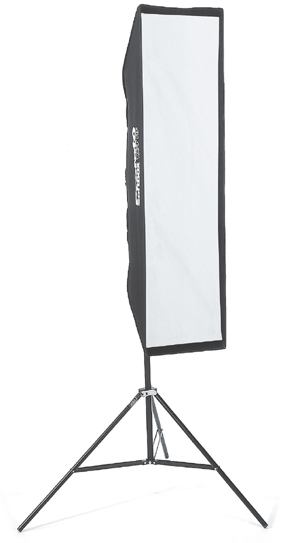
Covering or blocking portions of the illuminated surface of a softbox can change the shape of the light
(Courtesy of Chimera)
Hard Light Modifiers
Just as soft light is a matter of degree, so is hard light. At the other end of the specular/diffuse spectrum, we also have equipment that modifies light to different amounts of specularity.
At the sharpest, hardest end of the specular/diffuse dynamic are spotlights. Powerful lenses focus the light and bring all the light rays together at the desired place. Because the rays converge at one location, this light is very hard.
Fresnel lights produce collimated light, which means that the light is in a column with all the rays parallel and well defined. The name comes from the inventor of the lens, Augustin-Jean Fresnel. This type of lens is lightweight with a very short focal length. The light quality from a Fresnel lens is hard, and its light pattern falls off rapidly.
Variable spotlights are a function of the shape of the reflector and the position of the flashtube within it. As the flashtube moves closer to the front of the reflector, the light floods a larger area. Because the light source is open to the subject, the light remains specular. This setup is known as a zoom spot. The deeper and the more parabolic the reflector, the more concentrated the light.
With all these light modifiers—spotlights, Fresnel, and variable spots—the LD Edges have short transitions and the highlights are smaller and more defined. The more specular and shiny the lit surface, the tighter the highlight.
Parabolic reflectors create hard light similar to that of a Fresnel light. Because the basic design of this type of reflector is shallow, the light will be collimated if it is positioned near the focus of the parabola. However, since the flashtube is open to the subject, the light takes on some characteristics of a floodlight, thus softening the overall affect of the modifier. The LD Edge will have the characteristic of any dome used on the flashtube, and the highlight will take on the characteristic of the dome. A clear dome produces a specular highlight, and a frosted dome creates a softer and more diffused highlight.

Fresnel lens attachment (Courtesy of Profoto)
Regardless of the other parts of the lighting setup, the smaller and farther the opening is from the light source, the crisper the light will be. This consideration affects three common modifiers: snoots, grids, and egg crates. Snoots are extensions from the front of the flash reflector that allow the light to shine only through a small opening away from the flashtube, producing a small pattern of light. A grid is placed on the front of the reflector, forcing the light from the flashtube to pass through numerous openings made of parallel pieces of material. The deeper the grid, the less angular the spread of the light and the sharper the light. Grids increased in size are known as egg crates. Egg crates are attached to the front of a softbox. The depth of the egg crate controls the angle of the light coming from the surface of the softbox and therefore adds more directionality to the diffuse light. Louvers operate the same way as egg crates.

Egg crate (Courtesy of Chimera)
Grids fit directly over the light source and make the light more directional. The LD Edge is well defined and the shadows are dark. (Courtesy of Chimera)
Modifying Intensity
Light can be modified not only to change its characteristics, but also to change the amount of light to and from all or part of the portrait image. We can lighten or darken the image area or change the contrast ratio for all or part of the image.
Many pieces of lighting equipment have built-in variable intensity controls. Another, more readily available option is fine-tuning light by physically moving the lights. Based on the effects the Inverse Square Law (ISL), light can be varied in intensity by simply moving individual lights in or out. This is true for both direct and reflected intensities.
Since photographic stops (shutter speeds, f-stops, and ISOs) and the ISL are all based on the mathematical square function of the base 2, they work well together. For example, the full f-stops are 1.4, 2, 2.8, 4, 5.6, 8, 11, etc. They are related to the powers of the base 2 in that 1.4 is the square root of 2, 8 is 2 to the 3rd power, etc. Therefore, we find that if we move the light 1.4 times farther away from the subject, we halve the intensity of the light. If we move the light twice as far away from the subject, we reduce the light by two stops, and if we move the light 2.8 times away, we reduce the intensity by three stops. This relationship holds for all full stops as multipliers of distance change from the light. A caveat must be stated: these ratios hold most accurately for bare bulb setups measured on the light’s beam axis.
Modifying light by reducing it is often just as important to establish the correct portrait setting. We can reduce light by blocking it totally, diminishing it proportionally, patterning it, or absorbing its intensity.
Barndoors attached to the light source as blades or panels are hinged so that they can be positioned to restrict the light pattern. This restriction generates a shadow and a feathered LD Edge. The resulting light pattern consists of a fully lit area at the beam or in the illumination area, a shadow adjacent to the lit area, and feathered light in between.
Gels decrease light intensity evenly at the source. Their name comes from the gelatin that was formerly used in camera-based filters. Today’s gels are produced from heat-resistant plastics; the heat resistance is an important feature for gels used with electronic flash because modeling lights also generate heat. Neutral density gels decrease the intensity of the light without producing a color shift, while color gels decrease the intensity as they change the color. Color gels are used to change the atmosphere of a portrait, to match the color of artificial light to ambient light, or to make light take on a desired color.
Screens and scrims reduce light at the source similar to a grid, but without the depth; they provide only partial blocking. Metal screens are best since they are heat resistant. Scrims can be used over a softbox or behind the subject to reduce the intensity of a background. The scrim should be a dark, neutral tone and made of fine material. Also, the scrim must be placed outside the area of focus and be large enough to extend beyond the angular coverage of the camera.
Sometimes the light within a portrait setting is helpful to the image or flattens its contrast ratio. To control unwanted light, a flag can be used. Flags are made of black, heavy, textured material that absorbs ambient light and keeps it from entering the setting from the flag’s direction. This restricts the fill light that would normally enter the shadows, thus producing higher lighting ratios.
© Arthur Rainville (Courtesy of the artist)
Increasing or decreasing the flag’s angle changes the amount of light absorbed. Moving the flag closer and farther from the subject can also produce a noticeable change in lighting ratios. When the flag is close to a shadow area, the shadow will darken and the lighting ratio will be higher.
The flag is at one end of the continuum from maximum to minimum reflection. All surfaces reflect and absorb some light. When there is color present in a surface, the light reflecting from it will have a color bias. For example, photographing a portrait on a grassy area means that the light reflected from the ground will have a greenish cast and also that the shadows will be filled with greenish light. In turn, this will create a dulling of colors in the red spectral area. The reflection from a color surface is selective, diminishing complementary and accent colors in the same spectral range as the reflection.
To end this discussion about modifying light intensity, we come to cuculoris, or “cookie” (also spelled kookaloris or cucalorus). Cookies are cutouts used primarily to produce light patterns. For example, to simulate the light from a window, a cookie can be made that looks like a window and a focused light can be projected through the pattern. Cookies can also be used to block light in specific areas, such as removing an unwanted specular highlight by using a cookie in front of the key light.




